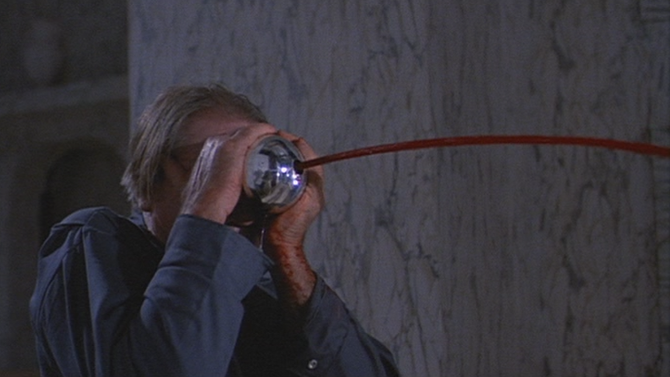The English language has so many fascinating and underused words: conundrum, copasetic, and, most importantly, at least to this review, phantasm. . . a term that I would likely not even know if it wasn’t for two distinct sources – the works of Edgar Allan Poe as well as the title of the 1979 horror film Phantasm and its sequels. Defined as a figment of the imagination or disordered mind, as well as an apparition of a living or dead person, Poe often used it in reference to his characters, who wandered around in a fugue state, while writer/director Don Coscarelli visualizes this word, concocting a fantastical dream-like (or should I say, nightmarish) horror landscape.
Seen through the eyes of thirteen year old Mike (A. Michael Baldwin), he is a boy who fears so much. Losing his parents to an accident, he constantly trails his older brother Jody (Bill Thornbury), worried that he too will leave him. To flash back for a moment, the movie actually opens with another death, that of a family friend who is killed after climaxing in a graveyard. . . the mysterious Lady in Lavender (Kathy Lester) finishing him off after she is satiated. Made to look like suicide, it is another unpleasant reminder of how death has haunted Mike’s short life. The only other person in their circle is Reggie (Reggie Bannister), a loyal, oft present friend of Jody’s.
Soon, the voyeuristic young teen, watching his brother at the funeral, spots something that is just not right. . . a tall, emaciated mortician (Angus Scrimm), looking more like a rigor mortised corpse than a living being, lifting a five hundred pound casket by himself after the mourners have departed.
Suspicious observations are continuously made by Mike, for when he follows his brother (who has picked up the same murderous lavender dressed lady at a bar) to the graveyard, he sees a short, hooded figure in the woods. . . soon, it attempts to attack him.
Investigating further, what he discovers inside the ancient funeral parlour, above and beyond its creepy, shadow-filled basement and lengthy marble mausoleum, is genuinely frightening. Leaving the dangerous locale with proof – a finger that oozes yellow liquid and lives on long after being severed, it convinces brother Jody that something foul is afoot. Will they be able to discover the horrific secrets of The Tall Man – stopping him in his evil tracks?
Like many other movies of the time (think Halloween and The Evil Dead), Phantasm transcends its minuscule budget (three hundred thousand) to create a visually rich, engaging film. Filled with some of the most splendid cinematography (also done by Coscarelli), the distinctive shadows of the mausoleum feel as if they are leading us, and the characters, toward a dreaded future, while the late day shadows and evening lit locations create a multi-layered, ominous effect. Camera placement and movement is also cleverly selected, it building a palpable suspense, while the simple yet effective villains (a skeletal suited mortician and dwarfish hooded figures) provide plenty of scares along the way. Perhaps the most impressive special effect is a hovering sphere that guards the mausoleum. . . when it attacks, two vampiric metal fangs protrude and latch on to the trespasser – drilling a hole in the body and sucking out every ounce of its blood and guts. Intriguingly, the effect was quite easy to achieve as the flying sphere was simply thrown (from behind the camera) by a baseball pitcher – the shot was then printed in reverse, giving us the sense that it was flying at us.
Not without touches of humour, friend Reggie provides some chuckles, while my favourite blink and you’ll miss it moment finds Jody being led by the sexually forward Lady in Lavender into the graveyard. . . as they enter, they pass a tombstone with the last name Bush on it, a gag that will be grasped more quickly by those who lived through the era compared to those who have come through the hairless and wax-centric society we live in today.
Though the story does have some issues, many of them can be shrugged away by the film’s title. . . after all, this is a figment of the imagination or disordered mind – its multiple dream sequences building on this mesmeric, peculiar aura. Despite these narrative flaws, there are so many standout moments – the aforementioned dream sequences (zombie like attacks that recall early Polanski and Romero), a jam session between Jody and Reggie (the song “Sittin’ Here at Midnight” was actually written by Thornbury), an ice cream truck crash, as well as so much more.
The score must also be mentioned. Composed by Fred Myrow and Malcolm Seagrave, it owes something to John Carpenter’s Halloween theme from a year earlier, though it has its own nuances and adds a spooky backdrop to the feature.
Part Buñuel, Hitchcock, Clouzot, Polanski and Romero, Coscarelli develops a unique feature that builds on the past masters, making a horror movie that has a message at its heart. Speaking of death and fear, it highlights the dour pain of mourning, while also being symbolic of each and every person’s coming of age – as we grow older, we must learn to face our fears, dealing with the loss of loved ones and other such things. Also influential, J.J. Abrams is a huge fan of the series – not only did he name his character Captain Phasma in Star Wars: The Force Awakens after the movie, but his Bad Robot Productions also aided in remastering the motion picture. So, awake from your stupor and mine this cult classic out of obscurity, it’s well worth it.


